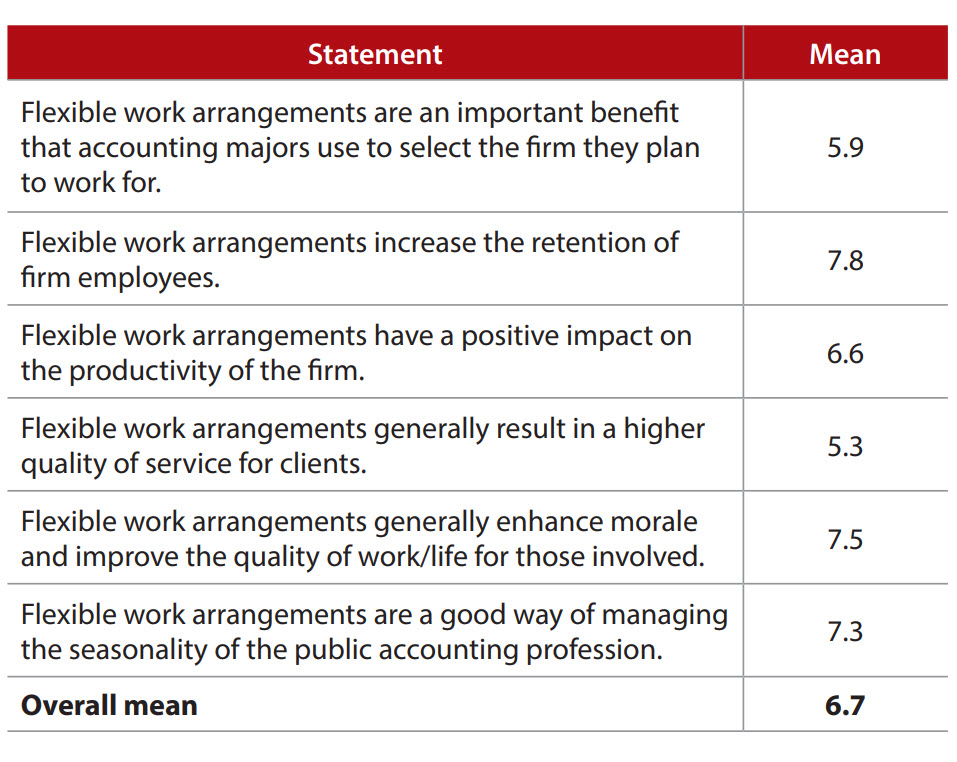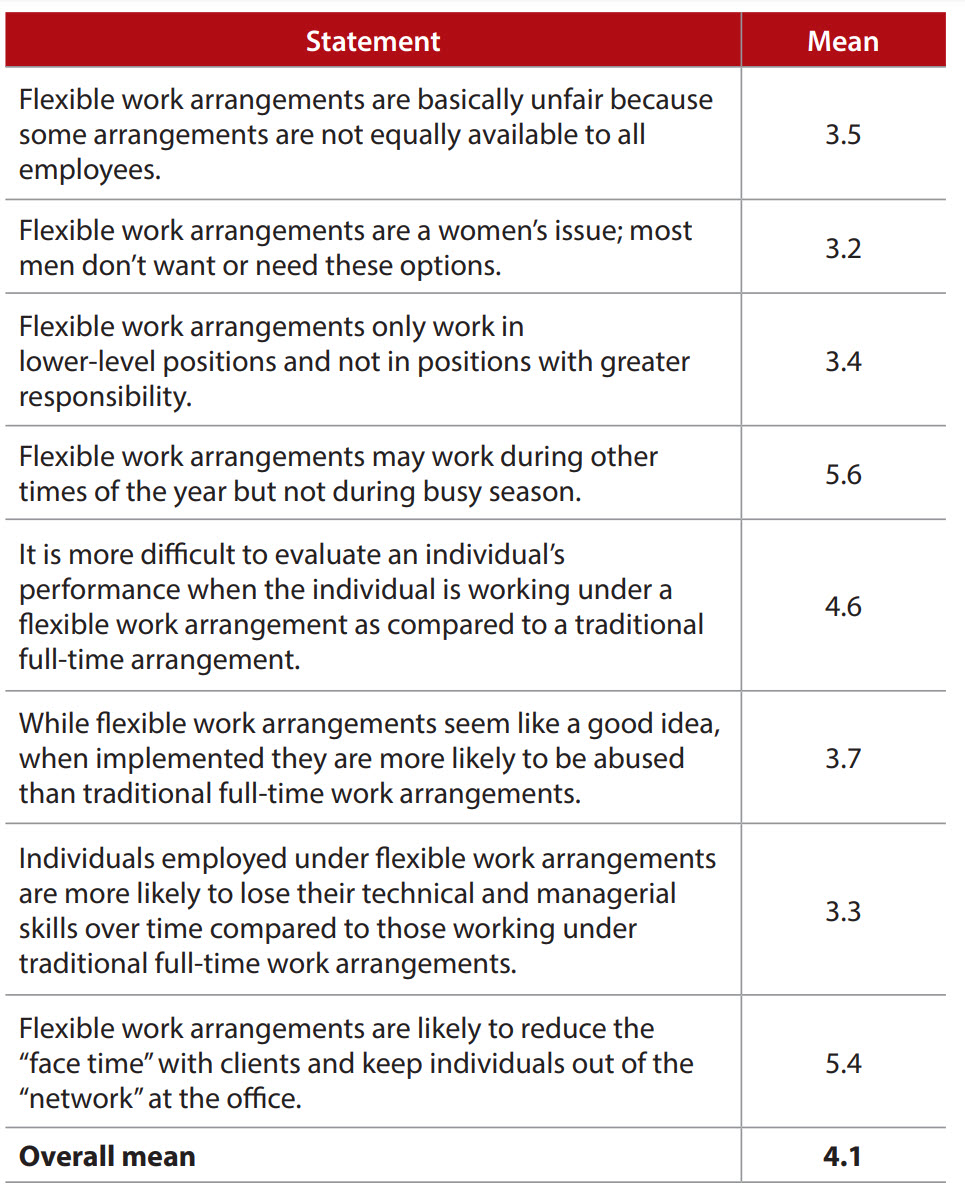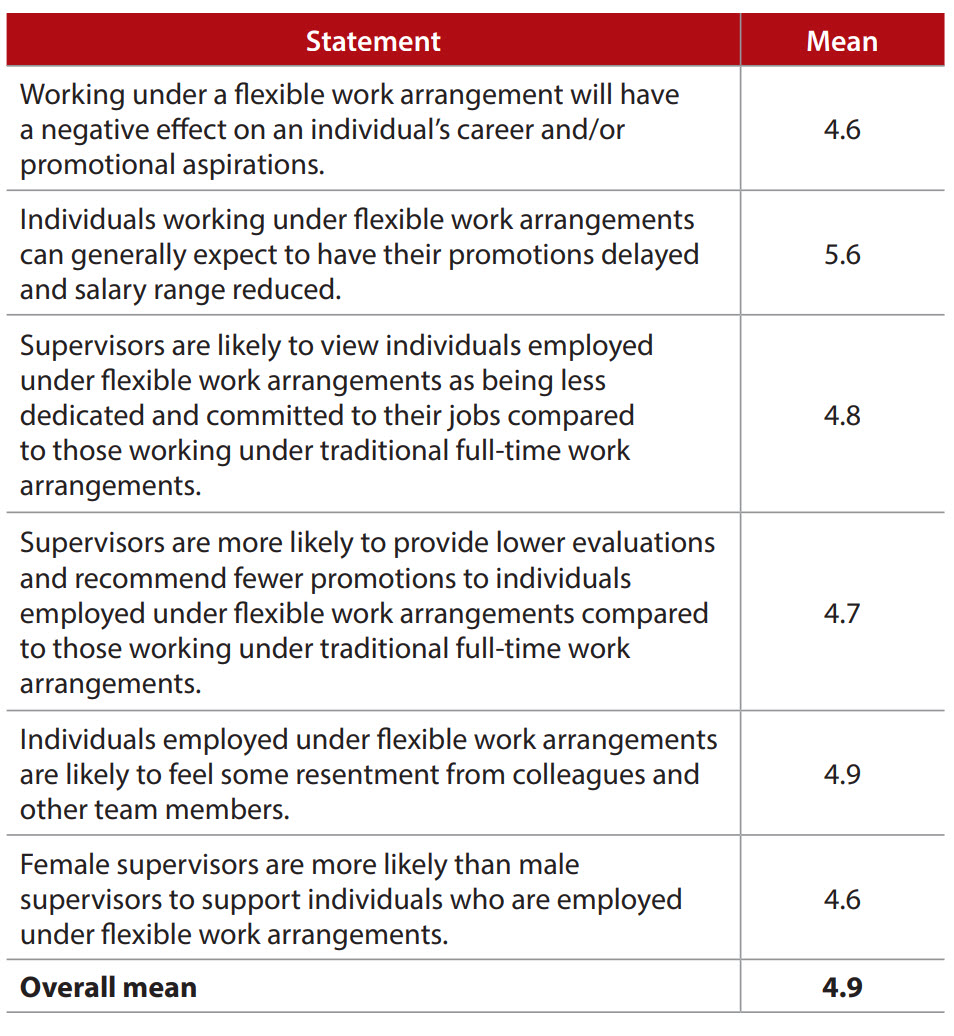- feature
- PRACTICE MANAGEMENT
Flexible work strategies for public accounting
Well-designed procedures can help CPA firms make effective use of remote work and employee-friendly scheduling.
Please note: This item is from our archives and was published in 2020. It is provided for historical reference. The content may be out of date and links may no longer function.

Related
4 reasons why CAS offers a compelling career path
Common audit claims and defenses
A firm grasp on growth: 6 strategies common among high-growth firms
Attracting and keeping qualified staff remains a top concern within the accounting profession, according to the 2019 AICPA Private Companies Practice Section CPA Firm Top Issues survey. Many firms are offering flexible work arrangements as a way to better compete for these talented people. The flexible work arrangements can include options such as flex time, reduced workloads, compressed workweeks, job sharing, and flex space (telecommuting). But how are these programs really perceived by professionals working in public accounting firms?
Professionals at all ranks and departments at four public accounting firms (one office of a Big Four firm; one office of a large, international firm; and two regional public accounting firms) were surveyed to determine how flexible work arrangements are perceived from three facets. The survey went to 402 professionals, and 113 responded. First, they were asked if public accounting professionals “buy in” to the potential benefits of flexible work (i.e., improved work/life balance, better retention). Second, do these professionals perceive any negative impacts to the firm as a result of allowing flexible work arrangements? Finally, do public accountants believe participation in these programs damages their careers?
These survey results give public accounting firms insights regarding the perceptions of flexible work from professionals of varying ranks and demographics. They also reveal recommendations for improving both the perception of flexible work arrangements and how they are used in order to maximize their effectiveness as retention tools.
‘BUY-IN’ ON THE BENEFITS
When asked about the intended goals and benefits of flexible work arrangements, respondents demonstrated fairly strong support or “buy-in” for them, with an overall mean of 6.7 on a 0-to-10 scale (0 = “Strongly Disagree”; 10 = “Strongly Agree”). Using survey questions developed by accounting scholars (Eric Johnson, David Lowe, and Philip Reckers) related to the goals and benefits of flexible work, professionals were asked their level of agreement with the statements in the table below.
General perceptions of flexible work arrangements

This level of buy-in is not completely surprising given that over 70% of the survey respondents were Millennials. Studies like the 2018 and 2019 Deloitte Millennial surveys indicate that Millennials prioritize work/life balance and flexibility, noting that flexibility is key to loyalty. Millennial opinions matter since that generation makes up much of the public accounting workforce.
Respondents at all ranks of the firm demonstrated fairly strong buy-in relative to flexible work arrangements. Demographics did, however, highlight a difference in responses for women as well as professionals who are already using flexible work arrangements. Women reported higher overall support for the goals and benefits of the arrangements with a reported mean of 7.2 compared with the mean of 6.4 reported by men. Current flexible work users also indicated higher levels of buy-in with a reported mean of 7.7 compared with the mean of 6.5 reported by those not participating in these programs.
ACCESSIBILITY IN QUESTION
The survey revealed surprising results regarding respondents’ perceptions of accessibility and transparency when it comes to flexible work. It appears that these arrangements are not perceived to work as well for the lower ranks in public accounting due to the amount of “face time” that staff and senior associates need to have with clients. These programs are also not perceived to be accessible to professionals at the staff and senior associate levels. The following survey comments illustrate this theme:
“I … feel like most employees would appreciate being able to work a flexible schedule, but feel uneasy about asking to do so, especially when they don’t have much time and experience put in at the firm yet.” — Staff associate
“[Flexible work arrangements] are perceived by firm management as a good way to attract and retain talent, but it’s only available to those who have proven themselves trustworthy.” — Senior manager
“I don’t think [flexible work arrangements] are perceived poorly; however, I do think they are made more available to managers and above. This is because managers and above more so have the ability to work from any location, whereas staff are more needed in person and work at the client site/from the office in a team environment.” — Senior associate
These results validate that firms should continue to use flexible work arrangements as a recruitment-and-retention tool, but they also indicate that firms need to assess the operational feasibility of these programs in the lower ranks and the perceived-versus-actual availability of them to those below the manager ranks in the firm.
TRANSPARENCY AND COMMUNICATION
Another theme that emerged from the survey is directly related to the question of flexible work accessibility that is discussed above. Respondents from all ranks of the firms expressed a need for greater transparency regarding flexible work eligibility and operational policies, as summarized by the following comments:
“I … think firm management is inclined not to ‘advertise’ alternative work arrangement options out of fear that more employees will want alternative work arrangements.” — Senior manager
“I believe the arrangements are given to some but not available to others, and this is unfair and breeds resentment.” — Staff associate
“Individuals need to be open to communication and respect the [flexible work] agreement. Everyone likes the idea of the arrangement until it affects their timelines.” — Partner
It appears that clearly defining and openly communicating both flexible work eligibility and specific operational protocols may go a long way toward “demystifying” flexible work arrangements (see the sidebar, “Quick Tips for Enabling Teamwork With Flexible Workers”). This theme, as well as the theme regarding flexible work accessibility in the lower ranks, emerged from an open-ended question at the end of the survey, which asked, “Overall, how do you believe alternative work arrangements are perceived at your firm?” Given that these were the two themes that respondents chose (unprompted) to discuss most frequently, these may be two key issues where firms should focus their attention in order to reap the maximum retention benefit from these highly sought-after flexible work arrangement programs.
FLEXIBILITY’S EFFECT ON FIRMS
Largely, respondents do not believe flexible work arrangements have a negative effect on firms. Respondents were asked about their level of agreement with the statements in the table below as a way of gauging perceived negative effects to the firm as a result of allowing flexible work.
Perceived negative effects of flexible work arrangements on firms

Overall, respondents displayed more disagreement than agreement with these types of statements, with a mean level of agreement of 4.1. Across the ranks, respondents believe there are more benefits to offering flexible work than there are negative consequences to the firms. It was noted, however, that women as well as professionals who already use flexible work arrangements are more supportive of the programs. These two groups perceive higher benefits and lower negative consequences to the firms compared with men and those not participating in a flexible work arrangement. If firms desire to present a “united front” about flexible work for both recruitment and retention purposes, they should consider probing further into the concerns shared by these two groups to see if they can be remedied. Perhaps clearer operational policies and procedures for flexible work, which are desired by many respondents, would be a means to such an end.
HOW FLEXIBILITY AFFECTS CAREERS
When asked about any personal career costs experienced by those participating in flexible work, respondents collectively seemed unsure. Respondents reported a mean score just shy of 5, which indicates neither agreement nor disagreement with the statements posed. To understand any perceived career damage for flexible work participants, the survey asked for respondents’ level of agreement with the statements in the table below.
Negative career consequences of flexible work arrangements

It should be good news to firms that there was not overwhelming agreement with these statements, but it is interesting that respondents did not feel compelled to express disagreement with these statements either. These findings reinforce that there is more work to be done to demystify flexible work arrangements. Professionals participating in flexible work actually perceive less career damage than professionals not participating in these programs. The flexible work participants, by themselves, reported a mean score of 4.0 on career damage questions, indicating they slightly disagree with the statements about the personal career damage experienced by flexible work participants. Their nonparticipant counterparts reported a mean score of 5.0. The comments supplied by flexible work participants echo their survey responses:
“We have quite a few individuals in my office that are on flexible arrangements, including reduced schedules, compressed workweeks, or working from home, and from what I have seen there are no hard feelings or negative consequences for those people (including myself).” — Manager
“Personally, I work remotely, and it has been a greatly positive experience. I was going to move out of state and was offered this arrangement, and it has greatly benefited both me and the firm. The cost of turnover is much greater than the cost of flying me back … a few times a year. I think the perception is that it doesn’t work for everyone but can be a great option to retain valuable employees with a strong sense of self-discipline.” — Senior associate
A contrasting comment from a professional not participating in a flexible work arrangement is reflective of this group’s concerns regarding career consequences:
“People who use [flexible work arrangements] in our office are often given less desirable work and are not given the same opportunities as those who do not use [them]. I wish I could utilize a [flexible work arrangement], as it would increase my likelihood to stay at my current firm; however, I fear using a [flexible work arrangement] will negatively impact my evaluations, and thus I would not progress in my career as quickly.” — Senior associate
For firms using flexible work as a recruitment-and-retention tool, these mixed results may point to issues surrounding transparency and education. Implementation of the best practices below may help demystify flexible work programs and improve employees’ understanding of how these programs may, or may not, impact their career trajectory at the firms.
BEST PRACTICES
Implementing best practices from the Society for Human Resource Management (SHRM) may improve both the functionality of flexible work programs and the current perceptions surrounding these programs at public accounting firms. Keep in mind that the more formalized the flexible work program, the better the results. Employees need clear policies regarding eligibility, approvals, program options, and expectations. Based on survey results, these formalized, widely communicated policies may be lacking in public accounting flexible work programs. Requiring employees to submit a flexible work request form or to sign a flexible work agreement as part of the approval process provides clarity to both the employee and employer regarding the type of arrangement desired, the proposed hours, expectations for meeting client demands, communication expectations, and measures of success. Recognize that launching flexible work programs with fewer options early on may provide the increased clarity and transparency that employees desire. The flexible work program can expand after initial implementation challenges are resolved and operational protocols are set.
To ensure proper communication occurs between team members, firms should provide remote communication tools so that workflow proceeds seamlessly between clients, in-office employees, and out-of-office employees. While many firms take advantage of instant messaging, videoconferencing is an easy way to connect with remote employees that preserves the visual cues and body language associated with in-person communication. Other collaborative technologies, such as Slack and Microsoft Teams, can be leveraged to offer group chatting and file sharing.
According to SHRM, another best practice relates to success metrics. Firms need to think carefully about the criteria that will be used to measure the success of their flexible work programs. Flexible work arrangements require a culture of trust rather than a culture of “presenteeism.” This means measuring results rather than hours logged face to face. Results-oriented performance indicators should be established upfront with flexible work participants, should be documented in the flexible work request form or flexible work agreement, and should be tracked and discussed regularly. This provides both parties clarity surrounding expectations and ensures that the flexible work benefits both the firm and the employee.
Firms are offering alternative work opportunities to combat turnover and foster the type of flexible culture that is needed to secure loyalty. Given how critical flexible work programs are in promoting and supporting work/life balance, firms should use the results of this survey as a catalyst to reexamine their own programs. It appears that improved communication and operational protocols may be key to unlocking the true retention-promoting potential of flexible work programs.
Quick tips for enabling teamwork with flexible workers
- Leverage technology like instant messaging and videoconferencing.
- Define upfront the frequency and timing of routine meetings, including virtual meetings.
- Develop a team schedule so each team member’s work schedule is transparently communicated.
- Create opportunities to get together in person; collectively decide on these events and activities.
About the authors
Margaret Knight, CPA, CGMA, DBA, is an assistant professor of accounting and director of the Master of Accounting program, and Regina Taylor, Ph.D., is an assistant professor of management, both at the Heider College of Business at Creighton University in Omaha, Neb.
To comment on this article or to suggest an idea for another article, contact Ken Tysiac, the JofA’s editorial director, at Kenneth.Tysiac@aicpa-cima.com or 919-402-2112.
AICPA resources
Articles
- “Ways to Keep Your Talented CPAs,” JofA, April 8, 2019
- “Make Your Firm’s Flex Options Stand Out,” CPA Insider, Jan. 28, 2019
- “How to Stay Productive When Working From Home,” CPA Insider, March 12, 2018
Online resource
- Flexibility Toolkit, aicpa.org (Private Companies Practice Section member login required)



















